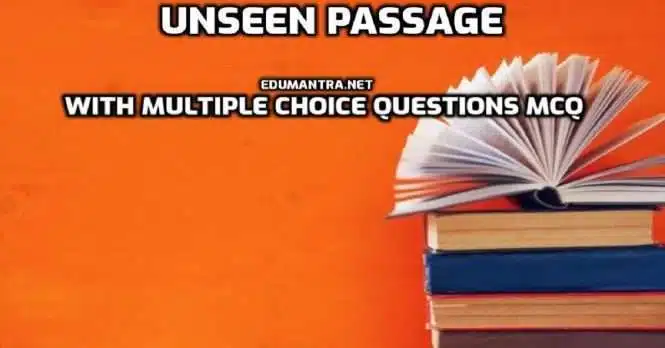
Edumantra brings to you a saga of unseen passage with multiple choice questions so practicing at least one essay a day is an easy task for you. When your mood is set to polish your writing skills and you are super confused about the apt unseen passage with multiple choice questions for class 9, just take a look at our collection and satiate your hunger for the same.
Passage – 26
Read the passage given below:
The UN’s 2017 International Year tells that sustainable tourism is an important tool for development, most importantly in poor communities and countries. Today sustainability —environmental, social, and economic—is increasingly recognised as the benchmark for all tourism business. As noted by the UN World Tourism Organisation, 57% of international tourist arrivals will be in emerging economics, by 2030. The various “Tourism Terms’ are defined as follows:
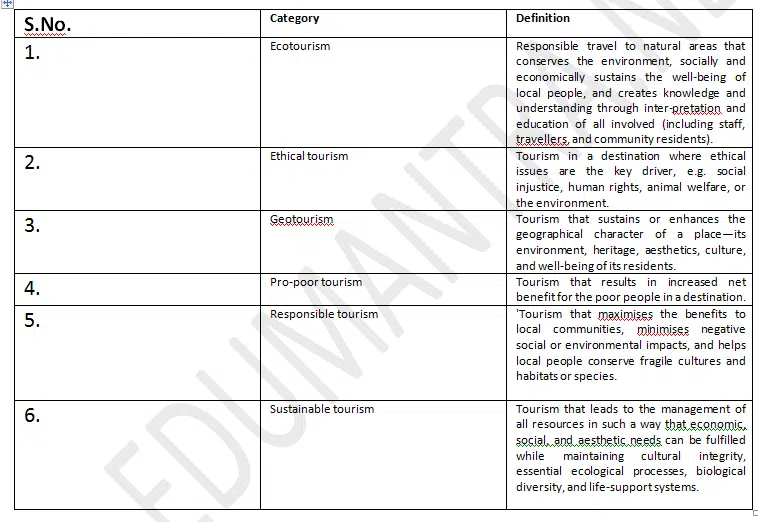
Based on data collected by a survey by Travel Bureau, the following market profile of an ecotourist was constructed:
Age: 35-54 years old, although age varied with activity and other factors such as cost.
Gender: 50% female and 50% male, although clear differences based on activity were found.
Education: 82% were college graduates a shift in interest in ecotourism from those who have high levels of education to those with less education was also found, indicating an expansion into mainstream markets.
Household Composition: No major differences were found between general tourists and experienced ecotourists. (experienced ecotourists = tourists that had been on at least one “ecotourism” oriented trip.)
Party Composition: A majority (60%) of experienced ecotourism respondents stated they prefer to travel as a couple, with only 15% stating they preferred to travel with their families and 13% preferring to travel alone.
Trip Duration: The largest group of experienced ecotourists—(50%) preferred trips lasting 8-14 days. Expenditure: Experienced ecotourists were willing to spend more than general tourists, the largest group (26%).
Important Elements of Trip: Experienced ecotourists top three responses were: (a) wilderness setting. (b) wildlife viewing. (c) hiking/trekking.
Motivations for ‘Taking Next Trip: Experienced ecotourists top two responses were: (a) enjoy scenery/nature. (b) new experiences/places.
On the basis of your understanding of the passage, answer the given questions:
1.In the line recognised as the benchmark”, the word “benchmark- DOES NOT refer to:
(i) a basis for something
(ii) the criterion required
(iii) the ability to launch something new
(iv) a standard point of reference
2.The World Tourism Organisation of the UN, in an observation, shared that:
(i) emerging economies of the world will gain 57% of their annual profits from International tourists
(ii) countries with upcoming economies shall see maximum tourist footfall from all over the world in the next decade
(iii) a large number of international tourists in 2030 will be from developing countries
(iv) barely any tourist in the next decade shall travel from an economically strong nation to a weak one
3.One of the elements that is important to ecotourists on trip is:
(i) wild and untouched surroundings
(ii) cultural exchange
(iii) car and bus rides
(iv) fully furnished flats
4.Choose the option that lists the correct answers for the following:
1.Asha Mathew, an NRI, Loves animals and wishes to travel to places that safeguard their rights and inculcate awareness of their rights. What kind of tourist is she?
2.Gurdeep Singh from UK is an environmental scientist and has always chosen to travel to places that are examples of a symbiotic relationship between man and nature. What kind of tourist is he?
(i)1 is an ecotourist and 2 is a geotourist
(ii)1 is an ethical tourist and 2 is a geotourist
(iii)1 is a sustainable tourist and 2 is a pro-poor tourist
(iv)1 is a geotourist and 2 is a responsible tourist
5.Based on your understanding of the passage, choose the option that lists the inherent qualities of geotourism.
1.Showcases adventure sports
2.Promotes landscape appreciations
3.Promises luxurious travel
4.Includes being environmentally responsible
5.Believes in commercialising forests
6.Initiates donations for the underprivileged
(i)1 and 2
(ii)5 and 6
(iii)2 and 4
(iv)3 and 5
6.In the market profile of an ecotourist, the information on gender indicates that:
(i)female ecotourists were more than the male ecotourists
(ii)the activity preferences were varied in females and males
(iii)the choice of things to do on a trip were quite similar for both the genders
(iv)male ecotourists were frequent travellers
7.The education aspect in the market profile of the ecotourist revealed that:
(i)mainstream market trends were popular with
(ii)undergraduates ecotourists were only those who had basic education
(iii)mainstream markets were popular tourist destinations for educated ecotourists
(iv)ecotourism was no more limited to the small group of highly educated travellers
8.According to the survey conducted by the Travel Bureau, the total percentage of experienced ecotourists who DID NOT prefer to travel alone was:
(i)60%
(ii)75%
(iii)15%
(iv)13%
9.According to the survey, one of the most powerful driving forces leading experienced ecotourism to invest in new trips was:
(i)setting up work stations in new places
(ii)the chance to go camping in the wild
(iii)competing with other ecotourists as frequent travellers
(iv)the opportunity to travel to new places
10.Choose the option that lists statement that is NOT true.
(i)Economically backward countries will benefit from sustainable tourism
(ii)The tourism business currently recognises sustainability as an important factor
(iii)Emerging economies will receive negligible international tourists in the near future
(iv)The sustainability factor in tourism is a significant means for development
11.The survey clearly showed that the age range of ecotourists:
(i)remained the same for the choice of tourist- attractions to visit
(ii)changed with the monetary requirements for the trip
(iii)fluctuated due to male-female ratio
(iv)was constant across various features of the trip
12.Who isn’t an experienced ecotourist?
(i)The person who has travelled as an ecotourist once earlier
(ii)The person who is yet to travel even once as an ecotourist
(iii)The person who is a regular ecotourism enthusiast and traveller
(iv)The person who is not regularly travelling on ecotourism trips
Answers:-
| 1.(iii) the ability to launch something new |
| 2.(ii) countries with upcoming economies shall see maximum tourist footfall from all over the world in the next decade |
| 3.(i) wild and untouched surroundings |
| 4.(ii) 1 is an ethical tourist and 2 is a geotourist |
| 5.(iii) 2 and 4 |
| 6.(ii) the activity preferences were varied in females and males |
| 7.(iv) ecotourism was no more limited to the small group of highly educated travellers |
| 8.(ii) 75% |
| 9.(iv) the opportunity to travel to new places |
| 10.(iii) Emerging economies will receive negligible international tourists in the near future |
| 11.(ii) changed with the monetary requirements for the trip |
| 12.(ii) The person who is yet to travel even once as an ecotourist |
CLASS 10 UNSEEN PASSAGE MCQ PDF MULTIPLE CHOICE TEST PDF
Passage – 27
Read the passage given below:
1. By 2030, a billion Indians will have access to the internet, about 839 million will be regular smartphone users and over 500 million will access digital content in regional languages according to KPMG India’s Media and Entertainment Report 2019 titled ‘India’s Digital Future. In the next decade, not only will the number of internet users double, but there will also be greater upward mobility.
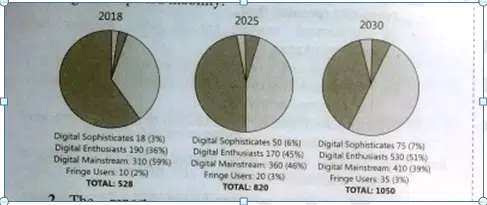
2. The report segments the country’s digital user base into four categories: Digital Sophisticates, primarily English and Hindi language speakers with an annual income over $70,000 (approximately Z 50 lakh) who will consume global, urbane and paywall-driven content; Digital Enthusiasts, who will earn between $8.500 (approx Z 6.08 lakh) and $70,000 (approx Z 50 lakh). and will lead smartphone usage, streaming services and demand for regional content; Digital Mainstream category, the $4,000 (approx Z 2.87 lakh) to $8,500 (approx Z 6.08 lakh) income group, who will consume free online or OTT-driven content on their smartphones in Hindi or regional languages; and Fringe users, who will have sporadic digital access due to poor connectivity or irregular income.
3. Digital Enthusiasts will become the single largest digital user group in India in the next decade due to rising income, easy availability of high-speed internet and confidence in going online. Comprising millennia’s (between 35 and 50 years in 2030) and generation-Z (25-35 years in 2030) who will be new entrants to the workforce, this category will “help shift the Indian digital story from one of passive consumption to deeper engagement and transactions”, says the report.
On the basis of your understanding of the passage, answer the given questions:
1.What does the above passage tell us about?
(i)Number of internet users
(ii)Number of internet users through cell phones
(iii)India’s digital future
(iv)All of the above
2.Which of the following explains the correct meaning of ‘fringe’?
(i)Sporadic
(ii)Connectivity
(iii)Marginal
(iv)Non-mainstream
3.Which category of consumers will become the largest Internet consumer group?
(i)Digital mainstream
(ii)Digital Enthusiast
(iii)Fringe users
(iv)Digital Sophisticate.
4.How many digital mainstream users are expected to grow by 2030?
(i)310 million
(ii)380 million
(iii)410 million
(iv)1050 million
5.Which of the following statements justify the reasons behind the increase in number of digital users?
I.They are global; urbane and paywall-driven content accessors.
II.They have greater upward mobility.
III.Risen Income group.
IV.Easy availability of Internet.
V.Preference is more for accessing online mode.
Choose the correct option for the correct answer:
(i)I. II. III
(ii) II. III. IV
(iii) III. IV. V
(iv) IV. V. I
6.Which income group is categorised with income between $8,500 and $70,000?
(i)Digital Enthusiasts
(ii)Digital Sophisticates
(iii)Digital Mainstream
(iv)Fringe Users
7.Which year will revolutionize Indian Digital story?
(i)2020
(ii)2025
(iii)2030
(iv)Both (ii) and (iii)
8.What is the expected percentage of increase in Digital Sophisticates category of users by the year 2030 with reference to year 2018?
(i)6%
(ii)7%
(iii)3%
(iv)4%
9.Which category of digital users wilt not find any change (increase/decrease) in their proportion in the year 2030 with reference to the year 2025?
(i)Digital Sophisticates
(ii)Fringe users
(iii)Digital Enthusiasts
(iv)Digital Mainstream
10.Which category of users fall under the category of fringe users?
(i)Those who have irregular income
(ii)Those who have poor connectivity access to interment
(iii)Those who are not the mainstream access
(iv)All of the above
11.How many Indians will have access to the internet in regional languages by 2030 as per the report?
(i)839 million
(ii)500 million
(iii)50 lakh
(iv)None of these
12.Which category of digital users in India will be the leader in smartphone Internet usage?
(i)Digital mainstream category
(ii)Fringe users
(iii)Digital Sophisticates
(iv)Digital Enthusiasts
Answers:-
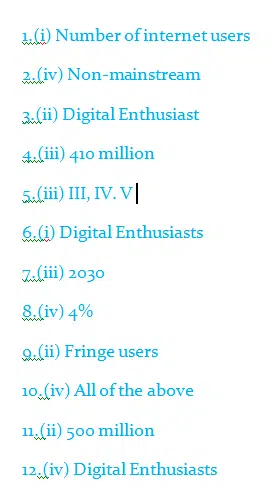
CLASS 10 UNSEEN PASSAGE MCQ PDF MULTIPLE CHOICE TEST PDF
We understand that 10th is a crucial year for your academic achievements and so we want you to build a strong foundation by writing unseen passage with multiple choice questions pdf with the help of us so your confidence level reaches one step ahead. An important part of your preparations is a good reading comprehension mcq section gives you the right path to boost your preparations and become a pro writer in no time.
Exercise- 28
Read the passage given below:
1. On 24 June 1859, Emperors Napoleon Ill and Franz Joseph I were engaged in the Battle of Sol fen no, commanding a combined total of about 2.70.000 troops onto the field for a single day of battle. Nearly 40.000 were either dead injured, or missing and many of them were simply left to die on the battlefield. Later spectators crowded the fields, looking for loved ones, searching for items they could sell, or for simply taking in the horrors of the bank. A Swiss businessman and social activist Jean Henri Dunant, who was travelling in Solferino, witnessed all this.
2. Jean Henri Dunant witnessed the atrocities of war as well as the helplessness of the countries not prepared or equipped to ease the suffering of those who had been injured in the Battle of Solferino. Dunant organised a group of volunteers to help bring water and food to the injured, to assist with medical treatment, or to write letters to the families of those who were dying. He also urged the public to create an organisation which would assist the wounded regardless of which side they fought for during the times of war. From that moment, he wrote the book. A Memory of Solferino. His writing inspired countless others to rally behind him in the creation of the International Federation of the Red Cross.
3. The modem day Red Cross began by devoting itself largely to the acts of disaster relief and epidemic treatment. This effort continues to this day. One of the easiest ways you can help the Red Cross is to make sure you are able to donate blood and make an appointment at the Red Cross website. But donating blood isn’t the only way you can help out—the Red Cross also encourages you to donate your time if you can. This is what the Red Cross wants everyone to know.
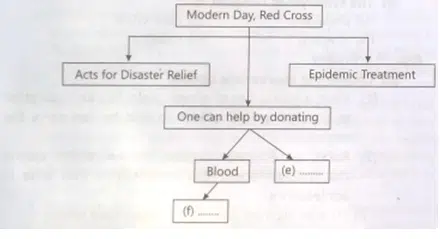
On the basis of your understanding of the passage, answer the given questions:
1.An appropriate subheading to Para 2 of the passage is:
(i)international Federation of the Red Cross
(ii) Functions of the Red Cross
(iii)The Contributions of Jean Henri Dunant
(iv)The Battle of Solferino
2.The aid provided by Dunant’s volunteers during the battle of Solferino was:
I.to help bring water and food to the injured
II.to assist with medical treatment
III.to write a book
IV.to give relief in epidemic.
(i)I and III
(ii) Ill and IV
(iii) I and II
(iv) II and III
3.soldiers fought In the Battle of Solferino on June 24.
(I)2.70,000
(ii)40.000
(iii)2.30.000
(iv)23,000
4.Choose the correct order of the information given below:
I.Dunant organised a camp of volunteers.
II. Emperor Napoleon III and Franz Joseph I fought a battle.
III. The book ‘A Memory of Solferino’ was written.
IV. Dunant travelled in Solferino.
(i)IV. III. II. I
(ii)I. II. III. IV
(iii)II. I. IV. III
(iv) II. IV.I. III
5.You can donate your blood and to the Red Cross.
(i)water
(ii)time
(iii)meals
(iv)books
6.To donate blood one should:
(i)make an appointment with society members
(ii)make an appointment at the Red Cross website
(iii)connect information from patients
(iv)collect information from neighbourhood
7.A Memory of Solferino’ was written by:
(i)Emperor Napoleon II
(ii)Franz Joseph I
(iii)Jean Henri Dunant
(iv) International Red Cross
8.The modern day Red Cross does not deal with:
(i)blood donation
(ii)disaster relief
(iii)epidemic treatment
(iv)writing a book
9.A word which means ‘act of brutality’ is:
(i)witnessed
(ii)helplessness
(iii)atrocity
(iv)equipped
10.The antonym of ‘discourage is:
(i)devoting
(ii)disaster
(iii) appointment
(iv)encourage
11……………. means ‘an individual or group who freely gives time to benefit others’.
(i)Troop
(ii)Volunteer
(iii)Public
(iv)Organisation
12.The opposite of ‘ancient’ is:.
(i)devoting
(ii)treatment
(iii)modern
(iv)donating
Answers:-
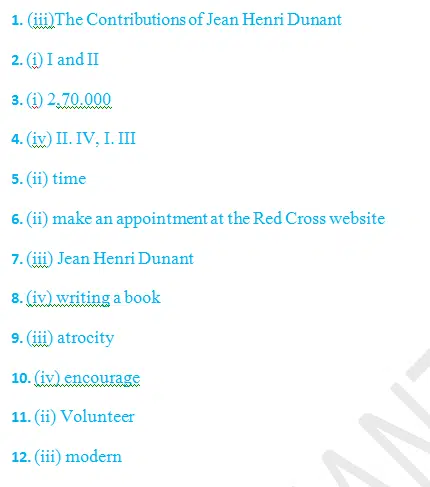
CLASS 10 UNSEEN PASSAGE MCQ PDF MULTIPLE CHOICE TEST PDF
Your search for class 9 unseen passage mcq brings you to edumantra’s website! Great! as this is where you should come time and again, for we offer you the best collection of essay references. Do not worry if you have no idea about class 10 unseen passage mcq , edumantra is here to guide you in this journey, as we will help you overcome your fears and become a pro very soon.
Exercise- 28
Read the passage given below:
1. Children in India live in diverse circumstances and have equally diverse needs and rights. Along with their need to be educated. healthy, and skilful, they need, and have rights to adequate nutrition, to live in a safe and supportive environment, have opportunities to reach their optimal potential and generally lead healthy joyful, and fulfilling lives so that they can become productive and well adjusted citizens of tomorrow.
2. Children in our country face many challenges. Many of them are first generation learners and face a myriad of problems throughout their schooling. Due to the socio-economic and cultural determinants, they may be vulnerable in many ways. Peer pressure and lack of positive role models May prow than to make unsafe and unhealthy choices. Anxiety and depresica amongst the students, to the point of turning them suicidal have been a cause for concem in the recent past .
3. Girls are more vulnerable and face discrimination at many levels from being unwelcome since birth to being pulled out of school for a variety of reasons. Dropping out of school, low motivation for academics, and general disinterest in sports and physical activities are some of the problems that need to be addressed.
4. Child malnutrition is rampant in most parts of the country. This has an adverse bearing on their cognitive capacities, learning performance, and physical capacity. India is one among the many countries where child malnutrition is severe. Malnutrition is a major underlying cause of child mortality in India. Trends in various nutritional indicator values and U5 mortality rate from 2000 to 2018 are shown in the figure below:

5. Our children have the right to have a good quality education. skill-building facilities, a safe and supportive environment, positive role models, empowerment, and friendly health services and counselling. Well-informed and skilled children are likely to make better decisions concerning their careers and relationships, habits, physical and mental health, and also will be successful and an asset to the society.
6. They also need to understand and deal with emerging issues like newly available career choices, pollution. water and energy conservation, global warming. protection of the environment, terrorism, and disasters. Dealing with anxiety and depression, negative peer pressure. violence, and accidents are some other significant issues that impact an individual’s health and also the social, economic and health indicators of the country. Gender sensitivity, prevention of female infanticide and good parenting are some important social aspects that all children need to understand. Children require guidance and assistance—both covert and overt from their parents teachers, peers and society in general to complete the various tasks of development and deal with such issues.
On the basis of your understanding of the passage, answer the given questions:
1. Well-informed children prove to be better than other children because:
(i)they are educated
(ii)they are aware of the world
(iii)they make qualified choices
(iv)they have ample career choice
2.Which of the following statements is not true?
(i)Child malnutrition is rampant in the country
(ii)Peer pressure leads to unhealthy choices of careers
(iii)Skilled children are diverted In careers
(iv)Children require guidance or counselling
3.The aim of good education is to make students:
(i)read and write properly
(ii)informed about career choices
(iii)aware about the better choice for themselves and for the world
(iv)prosperous and known
4.’………….. the problems that need to be addressed’, here ADDRESSED’ refers to:
(i)be looked into
(ii)be rejected
(iii)be written address on
(iv)be mistaken
5.The passage presents the observation that:
(i)children should be subjected to education only
(ii)children’s problems should not be a major concern
(iii)children’s growth should be the major concern for the society
(iv)children should not be given a new environment for growth
6.What percentage of children in 2005 didn’t show stunting?
(i)50%
(ii)40%
(iii)38%
(iv)52%
- The synonym of ‘rampant’ is:
(i)prevalent
(ii)controlled
(iii)checked
(iv)meagre - Choose the appropriate option:
(1)Virat, a young boy of eleven years has an inspiration to become an IAS officer so that he can serve the nation.
(2) Rohit, an educator creates an awareness among the children about the complexities that arise in adolescence.
(i)(1) is an aspirant and
(2)is a responsible citizen
(ii)(1) is a dreamer and
(2)is a teacher
(iii)(1) is irresponsible and
(2)is an aspirant
(iv)(1) is apprehensive and
(2)is a student - Girls in India face discrimination:
(i)from the moment they are born
(ii)even before they are born
(iii)throughout their life
(iv)from their mothers - What was most prevalent in children under five years in the year 2000?
(i)Stunting
(ii)Wasting
(iii)Polio
(iv)Under nourishment - What percentage(%) of under-five mortality rate was recorded in the year 2000?
(i)55%
(ii)30%
(iii)10%
(iv)25% - .Based on your understanding of the passage, pick the alternative that contains the inherent qualities of a role model.
1.Believes in God.
2.Always guides others.
3.Promises the well-being of others.
4.Always inspires others. - Wastes time.
(i) land 5
(ii) 2 and 4
(iii) 3 and 5
(iv) 4 and 5
Answers:-
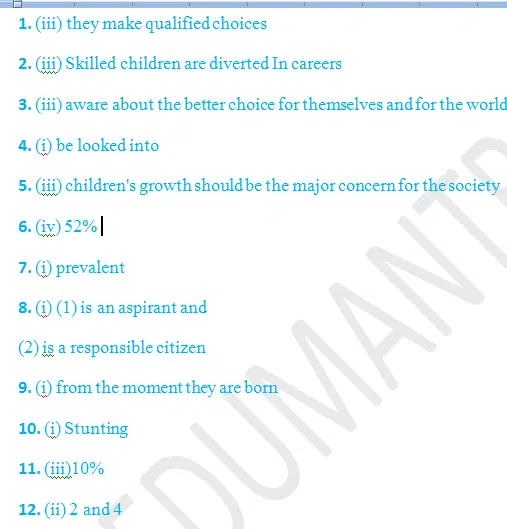
CLASS 10 UNSEEN PASSAGE MCQ PDF MULTIPLE CHOICE TEST PDF
Passage – 30
Read the passage given below:
Proportion that says each is their main gateway to news-INDIA
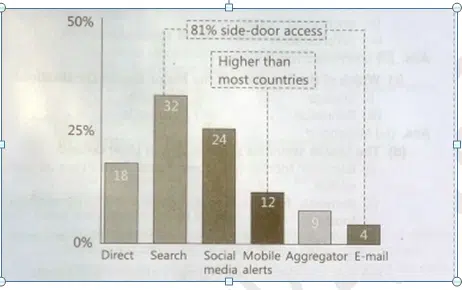
1. Online news and social media have outpaced print as the main source of news among those under 35 years of age, according to the Reuters India Digital News Report 2019. As many as 56% of the respondents said they prefer online news while 28% said they prefer social media. Only 16% said they prefer print.
2. According to the report, which studies how digital news is being used in India. 68% of respondents identify smartphones as their main device for online news and 31% say they only use mobile devices for accessing online news. These figures are markedly higher than in other markets. including developing ones such as Brazil and Turkey.
3. Further analysing how the sample accesses news, the report says that only 18% of the respondents consider direct access their main way of getting news online. An overwhelming majority of respondents identify various forms of distributed discovery as their main way of accessing news online with ‘search’ at 32%, and various kind of social media sources at 24%.
4. Within social media. Facebook and WhatsApp are particularly widely used, with 75% of the respondents using Facebook (arid 52% saying they get news there), and 82% using WhatsApp (with 52% getting news there). Other social media platform widely used for news are Instagram (26%), Twitter (18%) and Facebook Messenger (16%). Other key findings of the report:
5. Navigating news on social media: 56% of respondents say they decide on the basis of who shared the post, while for 63%, the headline is very important, and for 58%, the brand.
6. WhatsApp widely used for news: 82% use the messaging application, and 52% repotted getting news on WhatsApp, far higher numbers than most markets in Europe and North America, but comparable, for example, to Brazil. Online and offline sources of news: Among the respondents over 35, online (38%) and television (34%) are about equally widely named as the main source of news, and print (27%) still more widely relied on than social media (19%).
On the basis of your understanding of the passage, answer the given questions:
1.What does the given passage highlight?
(i) Popularity of online news over paperback newspaper
(ii) Sources of online news as means of information
(iii)Role of social media as a means of information
(iv) Both (ii) and (iii)
2.According to the information ………….of people prefer to seek information on the basis of its source.
(i) 16%
(ii) 34%
(iii) 56%
(iv) 27%
3.How much proportion of people prefer the paperback form of news as per Reuters India Digital News Report?
(i) 19%
(ii) 16%
(iii) 18%
(iv) 27%
4.Which source of digital news and information is most popular in India than any other country?
(i) Instagram
(ii) WhatsApp
(iii) Messaging application
(iv) All of these
5.Among those under 35 years of age prefer print.
(i) 28%
(ii) 56%
(iii) 169’o
(iv) 18%
6.Which mode of information has the greatest proportion as people’s main gateway to news?
(i) Direct
(ii) Social Media
(iii) Mobile Alerts
(iv) Search
7.As per the survey’s graphical comparison which source of information has more market capture in India in comparison to other countries?
(i) WhatsApp
(ii) Mobile Alerts
(iii) Social Media
(iv) Direct News
8.As per Reuters India Digital News Report 2019, how many people prefer online news?
(i) 24%
(ii) 32%
(iii) 56%
(iv) 28%
9.Apart from Facebook and WhatsApp which source is most preferred to get the news?
(i) Television
(ii) Instagram
(iii) Smartphone Alerts
(iv) All of these
10.Choose the correct option where India has been compared with developing countries alike India.
I. Europe
II. Brazil
III. Turkey
IV. North America
(i)I, II
(ii)III
(iii) II, III
(iv) IV. I
11.What are the factors that help people navigate news on social media?
(i) Use of Facebook and WhatsApp
(ii) On basis of the person sharing post
(iii)The headline of the news
(iv)Both (ii) and (iii)
12.Which source of online news shares the least contribution in India?
(i) E-mail
(ii) Messenger
(iii) Twitter
(iv) Direct source
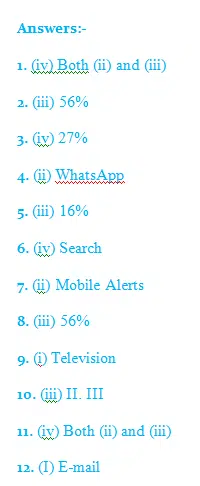
CLASS 10 UNSEEN PASSAGE MCQ PDF MULTIPLE CHOICE TEST PDF